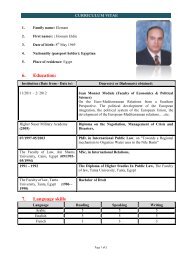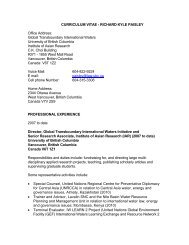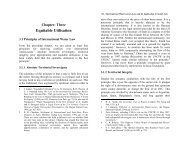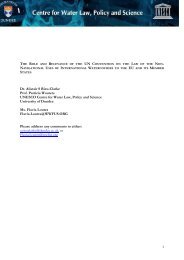Upreti, Trilochan, International Watercourses Law and Its Application ...
Upreti, Trilochan, International Watercourses Law and Its Application ...
Upreti, Trilochan, International Watercourses Law and Its Application ...
You also want an ePaper? Increase the reach of your titles
YUMPU automatically turns print PDFs into web optimized ePapers that Google loves.
196 / <strong>International</strong> <strong>Watercourses</strong> <strong>Law</strong> <strong>and</strong> <strong>Its</strong> <strong>Application</strong> in South Asia Prospects <strong>and</strong> Problems of Nepalese Water Resources / 197However, it has been argued that the treaty has attempted tofollow a model based on the principle of 'equitable utilisation'<strong>and</strong> 'no harm' principles. 49 Nonetheless, whether these conceptsare genuinely embodied is not clear, due to the ambiguityreflected in Articles 3 <strong>and</strong> 5 (1) as well as paragraphs 3 <strong>and</strong> 6 ofthe exchange of letters of the Mahakali treaty. The contentiouspart is the wording of 'respective consumptive use of the watersof the Mahakali River' without actually specifying the nature ofthe use. In the meantime the exchange of letters (exchange ofletters with this treaty), in paragraph 3 (b), contains somerestrictions as to the notion of equal entitlement, stating that:“it is understood that Paragraph 3 of Article 3 of theMahakali Treaty precludes the claim, in any form,by either party on the unutilized portion of theshares of the waters of the Mahakali River of thatParty without affecting the provision of thewithdrawal of the respective shares of the waters ofthe Mahakali River by each party under thisTreaty”.These provisions do not guarantee that equal entitlement ofwater, from a Nepalese st<strong>and</strong>point, should be half of the totaluse for each country. The term “existing consumptive use” is akey phrase adding to the confusion, whereas Article 5.1, whichstates that the “water requirements of Nepal are to be givenprime consideration”, contradicts the other provisions <strong>and</strong>creates ambiguity. It is obvious that India's consumptive use ishigher than Nepal’s which may impact on Nepal's plans toforgo part of her water entitlement in return for bearing aproportionately lower share of the costs of non-hydrocomponents. 50 That is to say, the treaty provides that the cost ofthe project will be shared proportionately to the benefits; ifIndia is able to define maximum existing use, the remainingwater use cost will be lower; this is the obvious reason for the49 Supra note 45, p. 111.50 Supra note 44, pp. 322-323.wrangling over the definition of consumptive use. However,Article V of the Helsinki Rules <strong>and</strong> Article 6 of the UNCIW,both state that existing use is only one of the factors to beconsidered in determining whether or not any specific use isequitable. Thus it seems, however, that the emphasis ondefining much quantum of water in terms of consumptive usemay not serve India’s interests as well as might have beenthought.The author had an opportunity to work as a member of aNepalese delegation to India in 1997 <strong>and</strong> 1998. In thenegotiations, Indian insistence on maintaining the existingvolume of water use at <strong>and</strong> beyond 160 km within herterritories was considered an illegitimate argument from thest<strong>and</strong>point of IWL, <strong>and</strong> Nepal has asserted this view. 51 Forinstance, 160 kilometres down from the Indo-Nepal border,India had diverted waters from the same river through anauxiliary canal, for which they (Indian) are claiming all existingconsumptive use, <strong>and</strong> expecting Nepal to recognise this. This isquestionable from a legal <strong>and</strong> political pointview. Nepal cannotbe expected to negotiate over issues so far from her border,within Indian territory, which is not part of the main Saradacanal, <strong>and</strong> could never raise the issues in time for theconclusion of this (Mahakali) treaty. On the contrary India wasalways raising the level of the aforementioned consumptiveuse, which Nepal has not debated; the dispute is about 201cusecs of water. 52 The argument put forward by Indiapertaining to the existing use 160 km below the border istantamount to supporting the absurd proposition that becausethe Farakka diversion of about 44,000 cusecs (although not forthe purpose of consumptive use) constitutes the consumptiveuse since 1975, that too must be guaranteed by Nepal.51 Nepal has insisted that she cannot negotiate with the resource which isnot in her jurisdiction or sovereignty.52 Supra note 10 p. 957.












